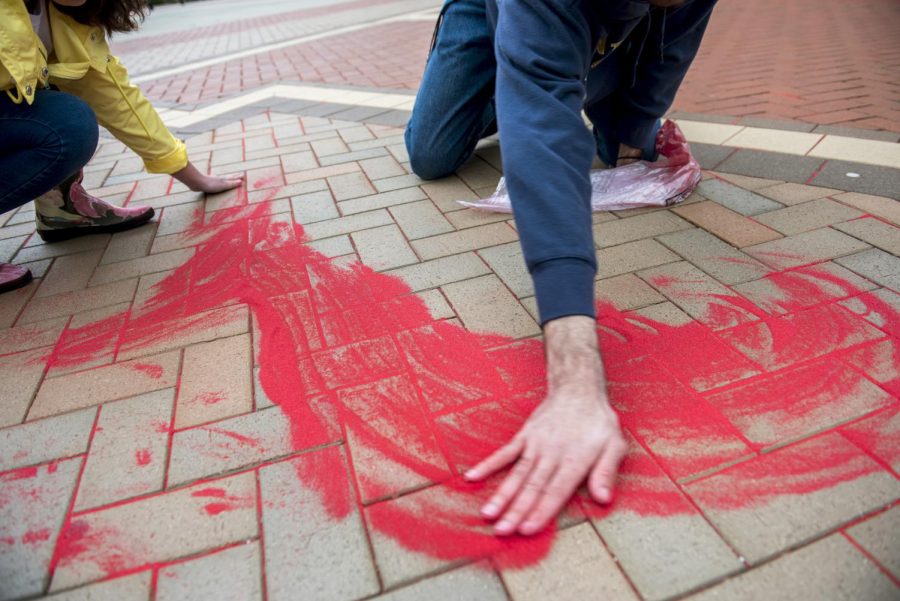IJM ensures human trafficking won’t fall through the cracks
Vice President of Kent’s International Justice Mission student organization Delaney Cordova and architecture sophomore Nathaniel Williams spread red sand into the cracks of the K in the middle of Risman Plaza Wednesday March 1. The Red Sand Project was started by artist Molly Goochman to bring awareness to the human trafficking epidemic.
March 1, 2017
Tornado warnings and rain didn’t stop the International Justice Mission (IJM) from filling in the cracks in the sidewalk along Risman Plaza Wednesday morning.
The movement — the “Red Sand Project” — raises awareness of human trafficking across the globe.
Despite weather warnings, members of IJM stood hunched over sidewalks and roads with small bags of ruby-red sand, filling in any holes or crevices. Members started at 9 a.m., wearing raincoats and clutching umbrellas.
Brooke Davis, junior communication studies major and president of Kent State’s chapter of IJM, described the purpose of the project.
“The ‘Red Sand Project’ is actually a separate movement from IJM, but they work to raise awareness for modern day slavery and for human trafficking, as well as a big social media campaign,” Davis said. “They really encourage people to take pictures of the red sand on the ground and in the cracks and upload it to social media to raise awareness.”
Delaney Cordova, a sophomore communication studies major and vice president of IJM, brought up the importance of a demonstration instead of other methods of spreading awareness.
“The ‘Red Sand Project’ is activism through artwork rather than being in people’s faces throwing statistics at people, which doesn’t really help or create any change,” Cordova said. “We’re just sparking people’s curiosity and starting conversations that then lead into being able to educate them on human trafficking and modern day slavery.”
The bright color of the sand is supposed to be shocking, Davis said.
“It looks really eerie, so people want to stop and ask, ‘Hey, what is this?’ and that’s your opportunity to talk about human trafficking and modern day slavery to people who might not have any idea.”
The sand is also symbolic of individuals the group wished to uplift. Davis said it represents those who have “fallen between the cracks in society.” This includes women who are forced into bondage and children used for cybersex trafficking.
Anyone was allowed to take part in the project. They could take a sand-filled bag and fill in cracks.
“We have little tool kits that have the information in them and packets of sand that students can have as they come and ask questions. They are more than welcome to join us and pour sand into the sidewalks, and many have,” Cordova said.
Matthew Tapparo, a freshman integrated social studies major and member of IJM, said he was grateful to join the organization and help spread the group’s message.
“I joined because human trafficking is a really big issue all around the world,” Tapparo said. “I want to help fight the injustices.”
He said he is optimistic that the project will inspire others to learn.
Davis said she plans on doing more projects similar to the “Red Sand Project” at least once a semester.
“It’s a really easy way to get involved and make a difference, because I think raising awareness is the biggest thing you can do to start the movement,” she said.
McKenna Corson is a diversity reporter, contact her at [email protected].

























